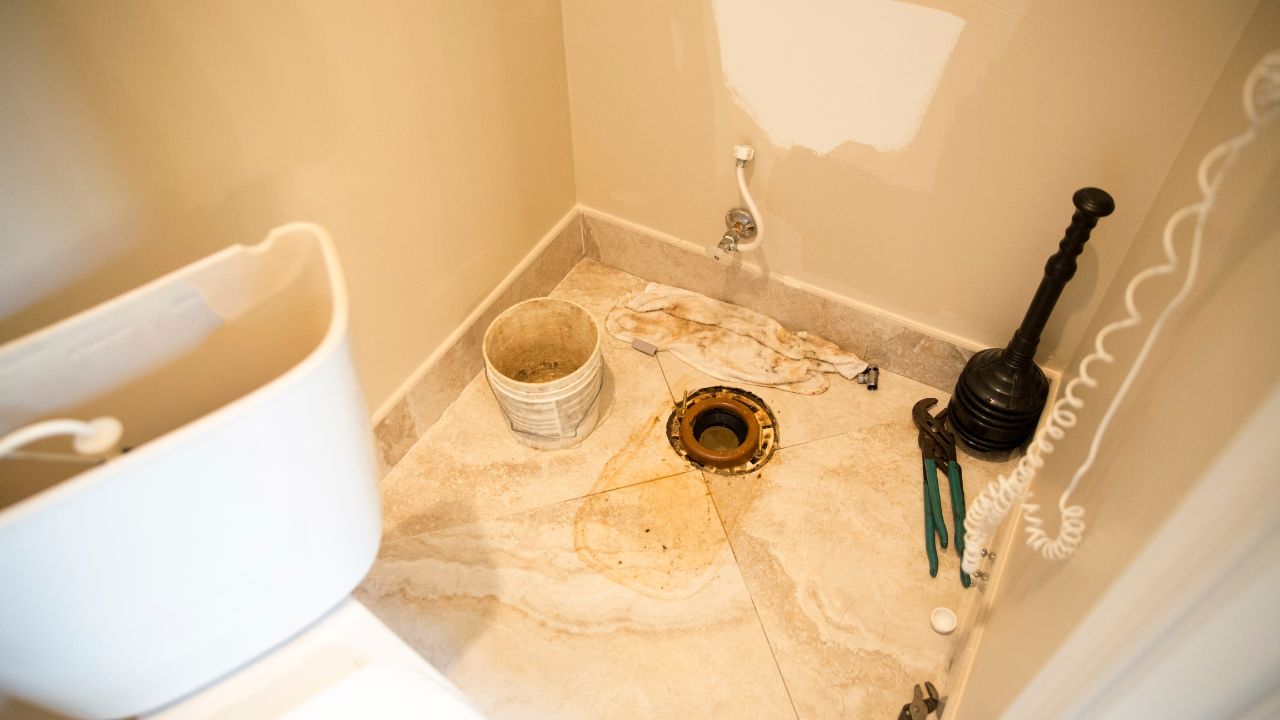Toilets are meant to flush and forget. But when one starts leaking, it quickly becomes something you can’t ignore. Whether it’s a small drip or a full-on puddle, a leaking toilet can waste water, damage your floor, or even lead to a messy ceiling leak.
This guide walks you through every kind of toilet leak—what causes it, how to fix it, and when to call a plumber. If you’ve noticed water where it shouldn’t be, keep reading.
1. How to Tell If Your Toilet Is Leaking
Not all leaks are loud or obvious. Some build up slowly. Here are signs to watch for:
- Water pooling around the toilet
- Damp bathroom floor even after wiping
- Discoloration on the ceiling below an upstairs toilet
- Moldy smell near the toilet
- Toilet that keeps refilling or running hours after use
- Spike in your water bill
If anything on that list sounds familiar, your toilet might be leaking from one or more spots.
2. Toilet Leaking at the Base or Bottom
This is one of the most common toilet problems. If water collects where the toilet meets the floor, the leak is likely at the base.
What Causes It:
- A worn-out wax ring seal under the toilet
- Loose bolts that hold the toilet down
- Cracked porcelain near the base
How to Fix It:
- Turn off the water at the shut-off valve.
- Flush the toilet and sponge out remaining water.
- Unscrew the toilet from the floor and carefully lift it off.
- Replace the old wax ring with a new one.
- Re-seat the toilet and tighten the bolts evenly.
Don’t overtighten the bolts or you might crack the base. If the toilet still leaks afterward, the floor flange could be damaged and may need replacement.
3. Toilet Leaking from the Tank
If you see water behind or beneath the tank (the upper part of the toilet), the leak is likely coming from the tank itself.
What Causes It:
- Loose tank bolts
- Worn rubber gaskets
- Cracks in the tank
- Old washers or corroded hardware
How to Fix It:
- Check that the bolts are snug but not overtightened.
- If the leak is from between the tank and bowl, replace the gasket.
- If you see fine cracks, you may need to replace the tank.
Be careful when tightening parts made of porcelain. It’s stronger than it looks—but still breakable.
4. Toilet Bowl Leaking or Water Slowly Leaking into Bowl
Sometimes, water leaks into the toilet bowl instead of outside the toilet. It may not look like a big deal, but it can waste hundreds of liters of water a day.
Signs:
- You hear a quiet trickle or hiss.
- The bowl refills on its own.
- You see movement in the water even when it hasn’t been flushed.
What Causes It:
- A worn or warped flapper
- A broken fill valve
- A dirty or corroded flush valve seat
How to Check:
- Put a few drops of food coloring into the tank.
- Wait 30 minutes.
- If the color shows up in the bowl, water is leaking from the tank.
How to Fix It:
- Replace the flapper—it’s an easy, cheap fix.
- If that doesn’t work, replace the fill valve.
5. Toilet Pipe Leaking Behind or Under the Tank
If you notice water dripping from the pipe behind the toilet or pooling beneath the supply line, the issue is probably in the plumbing connections.
What Causes It:
- Loose nuts or fittings
- Cracked supply hose
- Leaking shut-off valve
How to Fix It:
- Tighten all visible connections using a wrench.
- Replace the flexible supply line if it feels brittle or cracked.
- If the shut-off valve itself is leaking, it may need a replacement.
Always turn off the water before working on these parts.
6. Toilet Overflowed and Leaked Through Ceiling Below
If water spilled over from an upstairs toilet and you now see stains—or worse, dripping—from the ceiling below, this is more than a toilet problem. You now have water damage to deal with.
What to Do Immediately:
- Turn off the water at the shut-off valve.
- Soak up as much standing water as possible.
- Set up fans and open windows to dry the area.
- Check your ceiling. If it feels soft or bulging, you may need to cut it out and replace the drywall.
- Call a plumber to inspect the plumbing above.
Delaying this repair can lead to mold and expensive structural problems.
7. Step-by-Step Summary: Fixing a Leaking Toilet
Here’s a simple breakdown of common toilet leaks and how to handle them:
| Leak Location | Cause | Solution |
|---|
| Base | Worn wax ring | Replace wax ring and reset toilet |
| Tank | Loose bolts, bad gaskets | Tighten bolts or replace gaskets |
| Inside bowl | Flapper or fill valve problems | Replace flapper or fill valve |
| Supply pipe | Loose fitting or cracked line | Tighten or replace pipe |
| Ceiling leak | Overflow or broken pipe upstairs | Turn off water, inspect ceiling, call a plumber |
8. When to Call a Plumber
Some toilet leaks are simple enough to fix with a wrench and a little patience. But there are times when it’s smarter to bring in a professional:
- If the leak keeps coming back
- If you smell mold or mildew near the toilet
- If you notice damage on the ceiling or floor
- If the toilet wobbles or the floor around it feels soft
Trying to patch up a serious issue can cost you more later if it leads to structural repairs.
Frequently Asked Questions (FAQs)
Why is my toilet leaking at the bottom?
It’s likely the wax seal under the toilet has failed. Replacing it usually solves the problem.
What causes a toilet tank to leak?
Old gaskets, loose bolts, or cracks in the porcelain can all cause leaks from the tank.
How do I know if water is leaking into the bowl?
Add food coloring to the tank. If it shows up in the bowl without flushing, you have a leak.
Why is there water on the floor near my toilet pipe?
It could be a loose connection or a cracked water supply hose.
My upstairs toilet overflowed. Now my ceiling is leaking. What now?
Turn off the water, dry everything out, and call a plumber to inspect both the toilet and the ceiling.
Can I keep using a leaking toilet?
You shouldn't. It can lead to water damage, mold, and higher water bills.
Is it expensive to fix a leaking toilet?
Not always. Many parts cost under $20. Even professional repairs are cheaper than dealing with mold or floor damage later.
Should I replace the whole toilet if it leaks?
Usually not. Most leaks can be fixed by replacing a seal, valve, or hose.






